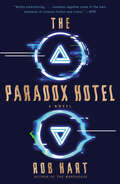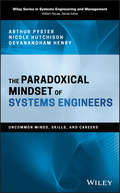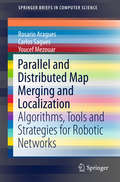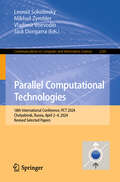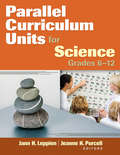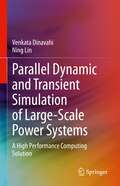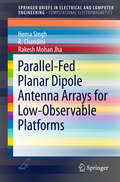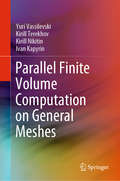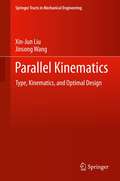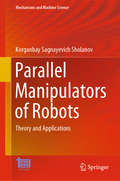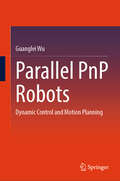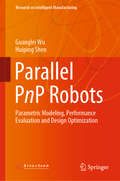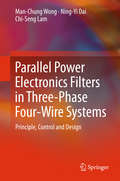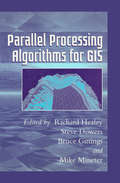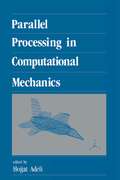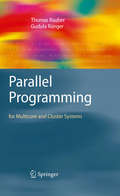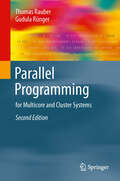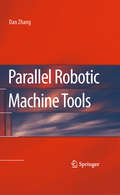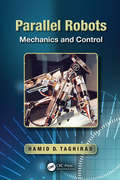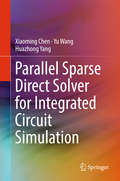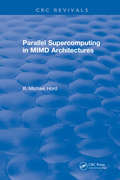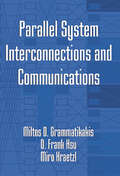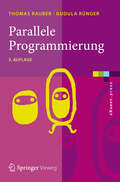- Table View
- List View
The Paradox Hotel: A Novel
by Rob HartAn impossible crime. A detective on the edge of madness. The future of time travel at stake. From the author of The Warehouse . . . &“An engrossing and thought-provoking sci-fi mystery that is also an achingly beautiful meditation on grief and the pain of lost love.&”—S. A. Cosby, New York Times bestselling author of Razorblade TearsONE OF THE MOST ANTICIPATED BOOKS OF 2022—CrimeReadsJanuary Cole&’s job just got a whole lot harder.Not that running security at the Paradox was ever really easy. Nothing&’s simple at a hotel where the ultra-wealthy tourists arrive costumed for a dozen different time periods, all eagerly waiting to catch their &“flights&” to the past.Or where proximity to the timeport makes the clocks run backward on occasion—and, rumor has it, allows ghosts to stroll the halls.None of that compares to the corpse in room 526. The one that seems to be both there and not there. The one that somehow only January can see.On top of that, some very important new guests have just checked in. Because the U.S. government is about to privatize time-travel technology—and the world&’s most powerful people are on hand to stake their claims.January is sure the timing isn&’t a coincidence. Neither are those &“accidents&” that start stalking their bidders.There&’s a reason January can glimpse what others can&’t. A reason why she&’s the only one who can catch a killer who&’s operating invisibly and in plain sight, all at once.But her ability is also destroying her grip on reality—and as her past, present, and future collide, she finds herself confronting not just the hotel&’s dark secrets but her own.At once a dazzlingly time-twisting murder mystery and a story about grief, memory, and what it means to—literally—come face-to-face with our ghosts, The Paradox Hotel is another unforgettable speculative thrill ride from acclaimed author Rob Hart.
The Paradoxical Mindset of Systems Engineers: Uncommon Minds, Skills, and Careers (Wiley Series in Systems Engineering and Management)
by Arthur Pyster Nicole Hutchison Devanandham HenryA guide that explores what enables systems engineers to be effective in their profession and reveals how organizations can help them attain success The Paradoxical Mindset of Systems Engineers offers an in-depth look at the proficiencies and personal qualities effective systems engineers require and the positions they should seek for successful careers. The book also gives employers practical strategies and tools to evaluate their systems engineers and advance them to higher performance. The authors explore why systems engineers are uncommon and how they can assess, improve, and cleverly leverage their uncommon strengths. These insights for being an ever more effective systems engineer apply equally well to classic engineers and project managers who secondarily do some systems engineering. The authors have written a guide to help systems engineers embrace the values that are most important to themselves and their organizations. Solidly based on interviews with over 350 systems engineers, classic engineers, and managers as well as detailed written career descriptions from 2500 systems engineers — The Paradoxical Mindset of Systems Engineers identifies behavioral patterns that effective systems engineers use to achieve success. This important resource: Offers aspiring systems engineers practical methods for success that are built on extensive empirical evidence and underlying theory Shows systems engineers how to visually document their relative strengths and weaknesses, map out their careers, and compare themselves to the best in their organizations – a rich set of tools for individuals, mentors, and organizations Offers practical guidance to managers and executives who lead systems engineering workforce improvement initiatives Written for systems engineers, their managers, business executives, those who do some systems engineering but primarily identify with other professions, as well as HR professionals, The Paradoxical Mindset of Systems Engineers offers the most comprehensive career guidance in the field available today.
Parallel and Distributed Map Merging and Localization
by Youcef Mezouar Carlos Sagues Rosario AraguesThis work examines the challenges of distributed map merging and localization in multi-robot systems, which enables robots to acquire the knowledge of their surroundings needed to carry out coordinated tasks. After identifying the main issues associated with this problem, each chapter introduces a different distributed strategy for solving them. In addition to presenting a review of distributed algorithms for perception in localization and map merging, the text also provides the reader with the necessary tools for proposing new solutions to problems of multi-robot perception, as well as other interesting topics related to multi-robot scenarios. The coverage is largely self-contained, supported by numerous explanations and demonstrations, although references for further study are also supplied. The reader will not require any prior background knowledge, other than a basic understanding of mathematics at a graduate-student level.
Parallel Computational Technologies: 18th International Conference, PCT 2024, Chelyabinsk, Russia, April 2–4, 2024, Revised Selected Papers (Communications in Computer and Information Science #2241)
by Leonid Sokolinsky Mikhail Zymbler Vladimir Voevodin Jack DongarraThis book constitutes the refereed post proceedings of the 18th International Conference on Parallel Computational Technologies, PCT 2024, held in Chelyabinsk, Russia, in April 2024. The 22 full papers included in this book were carefully reviewed and selected from 62 submissions. These papers have been organized under the following topical sections: High Performance Architectures, Tools and Technologies; Parallel Numerical Algorithms and Supercomputer Simulation.
Parallel Curriculum Units for Science, Grades 6-12
by Dr Jann H. Leppien Dr Jeanne H. PurcellBreathe new life into science learning with this powerful guidebook that shows how to create more thoughtful curriculum and differentiate lessons to benefit all students.
Parallel Dynamic and Transient Simulation of Large-Scale Power Systems: A High Performance Computing Solution
by Venkata Dinavahi Ning LinThis textbook introduces methods of accelerating transient stability (dynamic) simulation and electromagnetic transient simulation on massively parallel processors for large-scale AC-DC grids – two of the most common and computationally onerous studies done by energy control centers and research laboratories for the planning, design, and operation of such integrated grids for ensuring the security and reliability of electric power. Simulation case studies provided in the book range from small didactic test circuits to realistic-sized AC-DC grids, and special emphasis is placed on detailed device-level multi-physics models for power system equipment and decomposition techniques for simulating large-scale systems.Parallel Dynamic and Transient Simulation of Large-Scale Power Systems: A High Performance Computing Solution is a comprehensive state-of-the-art guide for upper-level undergraduate and graduate students in power systems engineering. Practicing engineers, software developers, and scientists working in the power and energy industry will find it to be a timely and valuable reference for solving potential problems in their design and development activities. Detailed device-level electro-thermal modeling for power electronic systems in DC grids;Provides comprehensive dynamic and transient simulation of integrated large-scale AC-DC grids;Offers detailed models of renewable energy system models.
Parallel-Fed Planar Dipole Antenna Arrays for Low-Observable Platforms
by Hema Singh R. Chandini Rakesh Mohan JhaThis book focuses on determination of scattering of parallel-fed planar dipole arrays in terms of reflection and transmission coefficients at different levels of the array system. In aerospace vehicles, the phased arrays are often in planar configuration. The radar cross section (RCS) of the vehicle is mainly due to its structure and the antennas mounted over it. There can be situation when the signatures due to antennas dominate over the structural RCS of the platform. This necessitates the study towards the reduction and control of antenna/ array RCS. The planar dipole array is considered as a stacked linear dipole array. A systematic, step-by-step approach is used to determine the RCS pattern including the finite dimensions of dipole antenna elements. The mutual impedance between the dipole elements for planar configuration is determined. The scattering till second-level of couplers in parallel feed network is taken into account. The phase shifters are modelled as delay line. All the couplers in the feed network are assumed to be four port devices. It is shown that the array RCS can be reduced considerably for a low observable platform by an optimization of array design parameters even in the presence of mutual coupling. This book presents a systematic step-by-step analytical formulation for RCS of planar half-wavelength centre-fed dipole arrays through various schematics and illustrations. The analytical description and analysis provided in this book should be useful for students, researchers, and design engineers of phased arrays.
Parallel Finite Volume Computation on General Meshes
by Yuri Vassilevski Kirill Terekhov Kirill Nikitin Ivan KapyrinThis book presents a systematic methodology for the development of parallel multi-physics models and its implementation in geophysical and biomedical applications. The methodology includes conservative discretization methods for partial differential equations on general meshes, as well as data structures and algorithms for organizing parallel simulations on general meshes. The structures and algorithms form the core of the INMOST (Integrated Numerical Modelling Object-oriented Supercomputing Technologies) platform for the development of parallel models on general meshes. The authors consider applications for addressing specific geophysical and biomedical challenges, including radioactive contaminant propagation with subsurface waters, reservoir simulation, and clot formation in blood flows. The book gathers all the components of this methodology, from algorithms and numerical methods to the open-source software, as well as examples of practical applications, in a single source, making it a valuable asset for applied mathematicians, computer scientists, and engineers alike.
Parallel Kinematics: Type, Kinematics, and Optimal Design
by Jinsong Wang Xin-Jun LiuParallel Kinematics- Type, Kinematics, and Optimal Design presents the results of 15 year's research on parallel mechanisms and parallel kinematics machines. This book covers the systematic classification of parallel mechanisms (PMs) as well as providing a large number of mechanical architectures of PMs available for use in practical applications. It focuses on the kinematic design of parallel robots. One successful application of parallel mechanisms in the field of machine tools, which is also called parallel kinematics machines, has been the emerging trend in advanced machine tools. The book describes not only the main aspects and important topics in parallel kinematics, but also references novel concepts and approaches, i.e. type synthesis based on evolution, performance evaluation and optimization based on screw theory, singularity model taking into account motion and force transmissibility, and others. This book is intended for researchers, scientists, engineers and postgraduates or above with interests in robotics and advanced machine tools technology such as parallel kinematics machines (PKMs). Xinjun Liu and Jinsong Wang, professors, work at The Institute of Manufacturing Engineering, Department of Precision Instruments and Mechanology, Tsinghua University.
Parallel Manipulators of Robots: Theory and Applications (Mechanisms and Machine Science #92)
by Korganbay Sagnayevich SholanovThis book describes the theoretical framework of parallel manipulators and presents examples of their application. The theoretical part begins with the theory of parallel manipulator synthesis. Working on this basis, various topology designs of one-loop and multiloop parallel manipulators are then obtained. The next section describes the zero parameters method for the analysis of mechanism (manipulator) structure with closed kinematic circuits, and includes examples of its application, highlighting its advantages compared to traditional methods. The book then presents the redundant parameters method for determining the position of special parallel manipulator links, and discusses its application in solving the direct problem of link position for multiloop manipulators. It also addresses one-loop and multiloop manipulators, and includes a solution for the direct and inverse link position problems of kinematics. In closing, the book presents a range of potential applications for parallel manipulator. These examples are intended to promote the development and implementation of new engineering solutions, e.g. in seismic protection systems, renewable energy and other areas. The book includes a wealth of material that can be used for teaching undergraduate, graduate and PhD students majoring in robotics, automation and related fields, and can also be used by researchers to solve problems in connection with introducing robotics technologies.
Parallel Operator Splitting Algorithms with Application to Imaging Inverse Problems (Advanced and Intelligent Manufacturing in China)
by Chuan He Changhua HuImage denoising, image deblurring, image inpainting, super-resolution, and compressed sensing reconstruction have important application value in engineering practice, and they are also the hot frontiers in the field of image processing. This book focuses on the numerical analysis of ill condition of imaging inverse problems and the methods of solving imaging inverse problems based on operator splitting. Both algorithmic theory and numerical experiments have been addressed. The book is divided into six chapters, including preparatory knowledge, ill-condition numerical analysis and regularization method of imaging inverse problems, adaptive regularization parameter estimation, and parallel solution methods of imaging inverse problem based on operator splitting. Although the research methods in this book take image denoising, deblurring, inpainting, and compressed sensing reconstruction as examples, they can also be extended to image processing problems such as image segmentation, hyperspectral decomposition, and image compression. This book can benefit teachers and graduate students in colleges and universities, or be used as a reference for self-study or further study of image processing technology engineers.
Parallel PnP Robots: Dynamic Control and Motion Planning
by Guanglei WuThis book provides the design and application of multiple control algorithms and motion planning to a family of parallel robots, which can be generalized to other robot counterparts. The book covers the fundamentals of dynamic models for control design, as well as a comparison of the control effects from the classical to advanced control algorithms step by step, which can help the researcher to understand the design procedure of control algorithms. It also includes different trajectory planning algorithms to ensure optimal robot performances. Furthermore, the research results previously scattered in many prestigious journals and conferences worldwide are methodically edited and presented in a unified form. The book is likely to be of interest to university researchers, R&D engineers, and graduate students in industrial parallel robotics who wish to learn the core principles, methods, algorithms, and applications.
Parallel PnP Robots: Parametric Modeling, Performance Evaluation and Design Optimization (Research on Intelligent Manufacturing)
by Guanglei Wu Huiping ShenThis book discusses the parametric modeling, performance evaluation, design optimization and comparative study of the high-speed, parallel pick-and-place robots. It collects the modeling methodology, evaluation criteria and design guidelines for parallel PnP robots to provide a systematic analysis method for robotic developers. Furthermore, it gathers the research results previously scattered in many prestigious international journals and conference proceedings and methodically edits them and presents them in a unified form. The book is of interest to researchers, R&D engineers and graduate students in industrial parallel robotics who wish to learn the core principles, methods, algorithms, and applications.
Parallel Power Electronics Filters in Three-Phase Four-Wire Systems
by Man-Chung Wong Ning-Yi Dai Chi-Seng LamThis book describes parallel power electronic filters for 3-phase 4-wire systems, focusing on the control, design and system operation. It presents the basics of power-electronics techniques applied in power systems as well as the advanced techniques in controlling, implementing and designing parallel power electronics converters. The power-quality compensation has been achieved using active filters and hybrid filters, and circuit models, control principles and operational practice problems have been verified by principle study, simulation and experimental results. The state-of-the-art research findings were mainly developed by a team at the University of Macau. Offering background information and related novel techniques, this book is a valuable resource for electrical engineers and researchers wanting to work on energy saving using power-quality compensators or renewable energy power electronics systems.
Parallel Power Electronics Filters in Three-Phase Four-Wire Systems: Principle, Control and Design
by Man-Chung Wong Ning-Yi Dai Chi-Seng LamThis book describes parallel power electronic filters for 3-phase 4-wire systems, focusing on the control, design and system operation. It presents the basics of power-electronics techniques applied in power systems as well as the advanced techniques in controlling, implementing and designing parallel power electronics converters. The power-quality compensation has been achieved using active filters and hybrid filters, and circuit models, control principles and operational practice problems have been verified by principle study, simulation and experimental results. The state-of-the-art research findings were mainly developed by a team at the University of Macau. Offering background information and related novel techniques, this book is a valuable resource for electrical engineers and researchers wanting to work on energy saving using power-quality compensators or renewable energy power electronics systems.
Parallel Processing Algorithms For GIS
by Richard Healey; Steve Dowers; Bruce Gittings; Mike MineterOver the last fifteen years GIS has become a fully-fledged technology, deployed across a range of application areas. However, although computer advances in performance appear to continue unhindered, data volumes and the growing sophistication of analysis procedures mean that performance will increasingly become a serious concern in GIS. Parallel computing offers a potential solution. However, traditional algorithms may not run effectively in a parallel environment, so utilization of parallel technology is not entirely straightforward. This groundbreaking book examines some of the current strategies facing scientists and engineers at this crucial interface of parallel computing and GIS.; The book begins with an introduction to the concepts, terminology and techniques of parallel processing, with particular reference to GIS. High level programming paradigms and software engineering issues underlying parallel software developments are considered and emphasis is given to designing modular reusable software libraries. The book continues with problems in designing parallel software for GIS applications, potential vector and raster data structures and details the algorithmic design for some major GIS operations. An implementation case study is included, based around a raster generalization problem, which illustrates some of the principles involved. Subsequent chapters review progress in parallel database technology in a GIS environment and the use of parallel techniques in various application areas, dealing with both algorithmic and implementation issues.; "Parallel Processing Algorithms for GIS" should be a useful text for a new generation of GIS professionals whose principal concern is the challenge of embracing major computer performance enhancements via parallel computing. Similarly, it should be an important volume for parallel computing professionals who are increasingly aware that GIS offers a major application domain for their technology.
Parallel Processing in Computational Mechanics (New Generation Computing Ser. #2)
by Hojjat AdeliIntroduces mechanical engineers to high-performance computing using the new generation of computers with vector and parallel processing capabilities that allow the solution to problems beyond the ken of traditional computers. The chapters present an introduction and overview, explain several methodo
Parallel Programming
by Thomas Rauber Gudula RüngerInnovations in hardware architecture, like hyper-threading or multicore processors, mean that parallel computing resources are available for inexpensive desktop computers. In only a few years, many standard software products will be based on concepts of parallel programming implemented on such hardware, and the range of applications will be much broader than that of scientific computing, up to now the main application area for parallel computing. Rauber and Rünger take up these recent developments in processor architecture by giving detailed descriptions of parallel programming techniques that are necessary for developing efficient programs for multicore processors as well as for parallel cluster systems and supercomputers. Their book is structured in three main parts, covering all areas of parallel computing: the architecture of parallel systems, parallel programming models and environments, and the implementation of efficient application algorithms. The emphasis lies on parallel programming techniques needed for different architectures. The main goal of the book is to present parallel programming techniques that can be used in many situations for many application areas and which enable the reader to develop correct and efficient parallel programs. Many examples and exercises are provided to show how to apply the techniques. The book can be used as both a textbook for students and a reference book for professionals. The presented material has been used for courses in parallel programming at different universities for many years.
Parallel Programming: for Multicore and Cluster Systems
by Gudula Rünger Thomas RauberInnovations in hardware architecture, like hyper-threading or multicore processors, mean that parallel computing resources are available for inexpensive desktop computers. In only a few years, many standard software products will be based on concepts of parallel programming implemented on such hardware, and the range of applications will be much broader than that of scientific computing, up to now the main application area for parallel computing. Rauber and Rünger take up these recent developments in processor architecture by giving detailed descriptions of parallel programming techniques that are necessary for developing efficient programs for multicore processors as well as for parallel cluster systems and supercomputers. Their book is structured in three main parts, covering all areas of parallel computing: the architecture of parallel systems, parallel programming models and environments, and the implementation of efficient application algorithms. The emphasis lies on parallel programming techniques needed for different architectures. For this second edition, all chapters have been carefully revised. The chapter on architecture of parallel systems has been updated considerably, with a greater emphasis on the architecture of multicore systems and adding new material on the latest developments in computer architecture. Lastly, a completely new chapter on general-purpose GPUs and the corresponding programming techniques has been added. The main goal of the book is to present parallel programming techniques that can be used in many situations for a broad range of application areas and which enable the reader to develop correct and efficient parallel programs. Many examples and exercises are provided to show how to apply the techniques. The book can be used as both a textbook for students and a reference book for professionals. The material presented has been used for courses in parallel programming at different universities for many years.
Parallel Robotic Machine Tools
by Dan ZhangResearch and development of various parallel mechanism applications in engineering are now being performed more and more actively in every industrial field. Parallel robot based machine tools development is considered a key technology of robot applications in manufacturing industries. The material covered here describes the basic theory, approaches, and algorithms in the field of parallel robot based machine tools. In addition families of new alternative mechanical architectures which can be used for machine tools with parallel architecture are introduced. Given equal importance is the design of mechanism systems such as kinematic analysis, stiffness analysis, kinetostatic modeling, and optimization.
Parallel Robots: Mechanics And Control
by Hamid D. TaghiradParallel structures are more effective than serial ones for industrial automation applications that require high precision and stiffness, or a high load capacity relative to robot weight. Although many industrial applications have adopted parallel structures for their design, few textbooks introduce the analysis of such robots in terms of dynamics and control. Filling this gap, Parallel Robots: Mechanics and Control presents a systematic approach to analyze the kinematics, dynamics, and control of parallel robots. It brings together analysis and design tools for engineers and researchers who want to design and implement parallel structures in industry. Covers Kinematics, Dynamics, and Control in One Volume The book begins with the representation of motion of robots and the kinematic analysis of parallel manipulators. Moving beyond static positioning, it then examines a systematic approach to performing Jacobian analysis. A special feature of the book is its detailed coverage of the dynamics and control of parallel manipulators. The text examines dynamic analysis using the Newton-Euler method, the principle of virtual work, and the Lagrange formulations. Finally, the book elaborates on the control of parallel robots, considering both motion and force control. It introduces various model-free and model-based controllers and develops robust and adaptive control schemes. It also addresses redundancy resolution schemes in detail. Analysis and Design Tools to Help You Create Parallel Robots In each chapter, the author revisits the same case studies to show how the techniques may be applied. The case studies include a planar cable-driven parallel robot, part of a promising new generation of parallel structures that will allow for larger workspaces. The MATLAB® code used for analysis and simulation is available online. Combining the analysis of kinematics and dynamics with methods of designing controllers, this text offers a holistic introduction for anyone interested in designing and implementing parallel robots.
Parallel Sparse Direct Solver for Integrated Circuit Simulation
by Xiaoming Chen Yu Wang Huazhong YangThis book describes algorithmic methods and parallelization techniques to design a parallel sparse direct solver which is specifically targeted at integrated circuit simulation problems. The authors describe a complete flow and detailed parallel algorithms of the sparse direct solver. They also show how to improve the performance by simple but effective numerical techniques. The sparse direct solver techniques described can be applied to any SPICE-like integrated circuit simulator and have been proven to be high-performance in actual circuit simulation. Readers will benefit from the state-of-the-art parallel integrated circuit simulation techniques described in this book, especially the latest parallel sparse matrix solution techniques.
Parallel Supercomputing in MIMD Architectures
by R.Michael HordParallel Supercomputing in MIMD Architectures is devoted to supercomputing on a wide variety of Multiple-Instruction-Multiple-Data (MIMD)-class parallel machines. This book describes architectural concepts, commercial and research hardware implementations, major programming concepts, algorithmic methods, representative applications, and benefits and drawbacks. Commercial machines described include Connection Machine 5, NCUBE, Butterfly, Meiko, Intel iPSC, iPSC/2 and iWarp, DSP3, Multimax, Sequent, and Teradata. Research machines covered include the J-Machine, PAX, Concert, and ASP. Operating systems, languages, translating sequential programs to parallel, and semiautomatic parallelizing are aspects of MIMD software addressed in Parallel Supercomputing in MIMD Architectures. MIMD issues such as scalability, partitioning, processor utilization, and heterogenous networks are discussed as well.This book is packed with important information and richly illustrated with diagrams and tables, Parallel Supercomputing in MIMD Architectures is an essential reference for computer professionals, program managers, applications system designers, scientists, engineers, and students in the computer sciences.
Parallel System Interconnections and Communications
by Miltos D. Grammatikakis D. Frank Hsu Miroslav KraetzlThis introduction to networking large scale parallel computer systems acts as a primary resource for a wide readership, including network systems engineers, electronics engineers, systems designers, computer scientists involved in systems design and implementation of parallel algorithms development, graduate students in systems architecture, design, or engineering.
Parallele Programmierung
by Gudula Rünger Thomas RauberMultiprozessor-Desktoprechner, Cluster von PCs und Innovationen wie Hyperthreading oder Multicore-Prozessoren machen parallele Rechenressourcen allgegenwärtig. Die Ausnutzung dieser Rechenleistung ist jedoch nur durch parallele Programmiertechniken möglich. Das Buch stellt diese Techniken für herkömmliche Parallelrechner und für neuartige Plattformen umfassend dar. Neben den Grundlagen der parallelen Programmierung werden Programmierumgebungen wie Pthreads, Java-Threads, OpenMP, MPI oder PVM sowie die zugehörigen Programmiermodelle behandelt.
